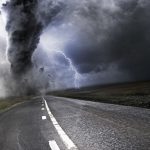You’re driving down the highway when a tornado warning is issued over your car radio. Is it safe to follow widespread advice and seek shelter under an overpass?
While the U.S. National Weather Service warns that the wind from a tornado can accelerate as it flows under the overpass, creating a wind tunnel effect, a new study found differently.
“In our research, there is no one finding that would suggest one should or should not use an overpass for protection from a tornado as a last-resort shelter area,” said study co-author D.M.L. Meyer, from the University of Rhode Island.
To assess the pressure, velocity and force fields of tornado-strength winds surrounding an overpass, the researchers conducted experiments with a scaled geometry of an overpass in a standard wind tunnel. A large fan drew air through the tunnel at a top speed of about 130 miles per hour.
The team studied four locations: immediately above the overpass; immediately below it; between the I-beams; and the center of the travel lane under the overpass. None of the experiments showed a wind tunnel effect.
“However, that doesn’t mean the effect doesn’t take place at all, just not in the locations we focused on,” Meyer explained. “More data and analyses are needed to determine how complex tornado-strength winds interact with the environment underneath an overpass, and our paper provides a start.”
The findings were published online Oct. 26 in the journal Physics of Fluids.
Even though the study didn’t find a wind tunnel effect, sheltering under an overpass during a tornado may still be dangerous, the researchers added in a journal news release.
Wind may not decelerate, depending on the location, and flying debris may reach areas of the overpass that appear to be protected from the wind.
More information
The U.S. National Weather Service offers tornado safety advice.
SOURCE: Physics of Fluids, news release, Oct. 26, 2021
Copyright © 2025 HealthDay. All rights reserved.



-300x169.jpg)












